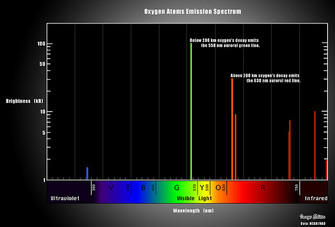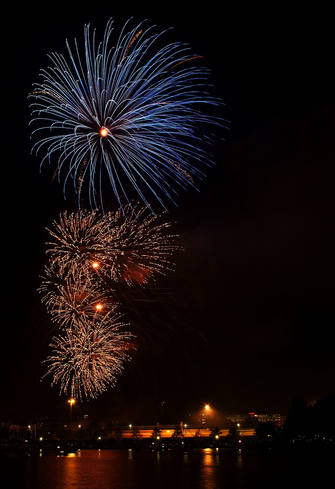« Prev Next »
Happy Fourth of July! It was actually a little more than a week ago, but nonetheless we at SciBytes hope you are having a fantastic month of July. Although apple pie and tons of barbecued foods are signature aspects of 4th of July celebrations, the event everyone anticipates are the nighttime fireworks. Before the Declaration of Independence, one of our founding fathers, John Adams, wrote to his spouse saying that he envisioned the celebration commemorating America's independence from Great Britain with "Pomp and Parade...Illuminations from one End of this Continent to the other from this Time forward forever more." Indeed, on the night of Independence Day, the skies are covered by a myriad of explosions in red, white, blue, yellow, green, and many other colors, with the power to expand up to 75 feet and radiate for well over 5 minutes. This is where the science comes in. Not only is the variety of colors used in fireworks displays derived from "carefully crafted" chemical reactions, but the shapes created by the explosions are also controlled by general physical principles.
Fireworks have been used for hundreds of years and definitely aren't exclusive to the US Independence Day. In fact, the art dates back all the way to ancient China, where gunpowder was discovered.

An aerial firework is primarily composed of a shell that contains four distinct parts. The container, the physical shell around the entire firework, is usually composed of pasted paper and string that can be formed into a cylinder or ball. The "stars" are spheres, cubes, cylinders, and other shaped objects that contain all the necessary ingredients for creating colored light and other special effects (the fuel-oxidizer system, different elements to create colors, etc.). The bursting charge is a firecracker-like object at the center of the shell. The fuse, attached to the bursting charge, provides the time delay so that the bursting charge, and therefore the rest of the firework shell, explodes at the right time and height. A simple shell is composed of a container filled with stars and black (gun) powder. When the bursting charge ignites, it causes the entire shell to explode.

The most important part of a fireworks display is creating good visual effects. These mainly arise from slower-burning reactions coming from within aerial fireworks. Pyrotechnic chemists aren't just trying to make an explosion; they want to illuminate the sky. To reduce the rate of the burning reaction produced by the fuel-oxidizer system, chemists use big grains of chemicals (typically the size of a grain of sand) and don't blend together the ingredients of the black powder thoroughly.

Now that we've discussed how the fireworks are created and controlled, let's go over the fun stuff: coloring and shaping. Every element releases energy in the form of a different colored light, almost like having a spectral fingerprint. The process involves releasing the energy stored within the atoms of a certain element. When atoms are exposed to light, which comes in the form of energy, their electrons become "excited." Excited electrons move to a higher energy level after absorbing the energy from an original light source. However, the electron cannot stay in an excited state forever.

The shape of the explosion mainly comes down to the construction of the aerial shells and the stars within them. According to Julie Heckman of the American Pyrotechnics Association, just inserting a piece of cardboard into the shell while making sure the stars are arranged around it will force the stars to explode in an outward pattern. What really matters, however, is the placement of the stars within the shell. If the stars are arranged in a certain shape within the shell itself, and if they are all ignited at the same time, the firework will look like that original shape.

The next time you are able to watch a fireworks display, keep track of the colors you see. The variety of elements used will always surprise you!
References:
1. HowStuffWorks. Marshall Brain. "How Fireworks Work." Science, Innovation (2013).
2. CBS News. Yana Paskova. "How fireworks work: The science behind pyrotechnic displays." Science (2014).
3. Scientific American. John A. Conkling. "Pyrotechnics." Fireworks (1990).
4. Takeo Shimizu. Pyrotechnica Publications. "Fireworks from a Physical Standpoint, Part II." (1983).
5. The National Institute of Higher Education, Research, Science, and Technology. "The Science Behind Fireworks." Sci-Bits (2012).
6. Live Science. Natalie Wolchover. "How Do Fireworks Make Shapes?" Life's Little Mysteries (2011).
7. The Royal Institution. Chris Bishop. "The Science of Fireworks!" Christmas Lectures (2012).
Image Credit (in order of appearance): Sedeer El-Showk (Flickr), Unknown (Flickr), David Hogan (Flickr), SciTechLab (Flickr), Sedeer El-Showk (Flickr)






















